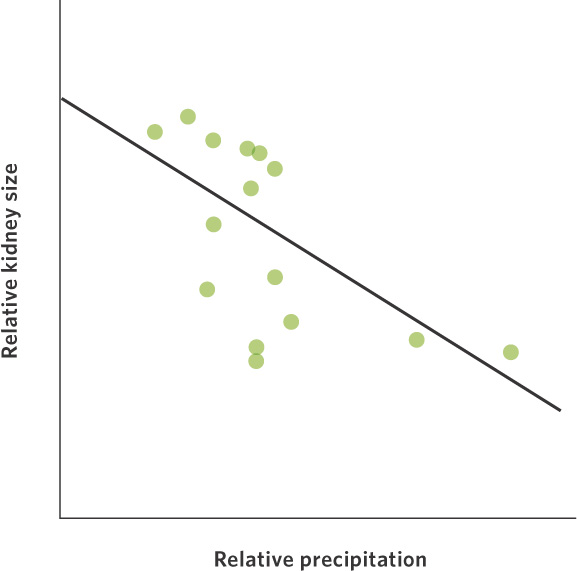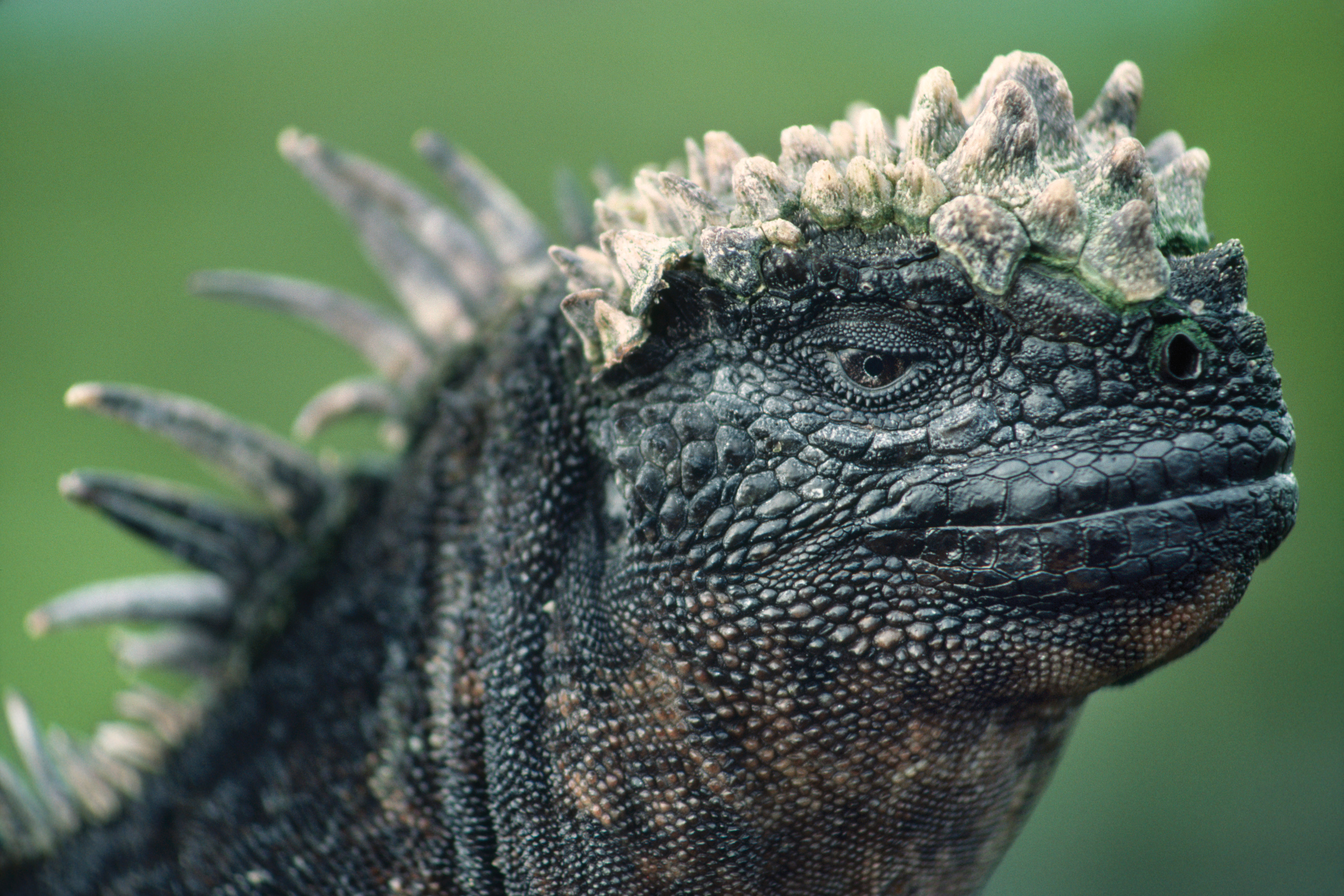Terrestrial environments pose a challenge for animals to balance water, salt, and nitrogen
Homeostasis An organism’s ability to maintain constant internal conditions in the face of a varying external environment.
While plants have a variety of adaptations for conducting photosynthesis on land, terrestrial life presents many additional challenges, including the need to maintain a balance of water, salt, and nitrogen. This balance is known as homeostasis. Homeostasis is an organism’s ability to maintain constant internal conditions in the face of a varying external environment. All organisms exhibit homeostasis to some degree—for example, the balance of water and salt, or the regulation of body temperature.
Although the occurrence and effectiveness of homeostatic mechanisms vary, all homeostatic systems exhibit negative feedbacks, meaning that when the system deviates from its desired state, or set point, internal response mechanisms act to restore that desired state. An example that might be familiar to you is the presence of negative feedbacks in the regulation of body temperature. Figure 3.14 shows how this works in mammals. The hypothalamus—a gland in the brain—determines whether the body temperature is above or below the desired set point, which differs among species of mammals. If body temperature drops below this set point, the hypothalamus uses neural and hormonal signals to trigger the body to generate more heat. When the body temperature reaches the set point, the hypothalamus triggers the body to stop producing heat. If the body temperature greatly exceeds the set point, the hypothalamus triggers the body to start using cooling mechanisms, including sweating and panting. This is much like how a thermostat regulates the temperature of a room; when the house is cold, a temperature-sensitive switch turns on a heater. Once the house warms up to the desired set point, the thermostat turns the heater off.

Negative feedbacks The action of internal response mechanisms that restores a system to a desired state, or set point, when the system deviates from that state.
72
In Chapter 2 we saw that to maintain the proper amounts of water and dissolved substances in their bodies, aquatic organisms must balance their gains and losses. This is equally true for organisms on land. Organisms often take in water with a solute concentration that differs from that of their bodies, so they must either acquire additional solutes to make up the deficit or rid themselves of excess solutes. If they do not balance the concentration of solutes, many of their physiological functions will not operate correctly. When water evaporates from the surfaces of terrestrial organisms into the atmosphere, solutes are left behind and their concentration in the body tends to increase. Under such circumstances, organisms must excrete excess salts to maintain the proper concentrations in their bodies.
Water and Salt Balance in Animals
Water is as important to terrestrial animals as it is to terrestrial plants. Terrestrial animals, with their internalized gas exchange surfaces, are less vulnerable to respiratory water loss than plants. Moreover, because terrestrial animals are not immersed continuously in water, they have little trouble retaining ions. They acquire the mineral ions they need in the water they drink and the food they eat, and they use urine to eliminate excess salts in their bodies. Where fresh water abounds, animals can drink large quantities of water to flush out salts that would otherwise accumulate in the body. Where water is scarce, however, animals make use of adaptations to conserve water.
As one would expect, desert animals have evolved a number of adaptations in response to water scarcity. Kangaroo rats, for example, are a group of small rodents that live in the dry regions of North America (Figure 3.15). Behavioral and physiological adaptations allow them to live in these places. The kangaroo rat conserves water by hunting for food during the nights and staying in a cool and humid underground burrow during the hot days—a valuable behavioral adaptation. For both the kangaroo rat and the camel, the kidneys provide an additional physiological adaptation to extreme heat and water scarcity. In all mammals, the kidneys are responsible for removing salts and nitrogenous wastes from the blood. These solutes are dissolved in water, but because water is valuable, a structure known as the loop of Henle helps recover some of it before the mixture is excreted. Kangaroo rats and camels possess an unusually long loop of Henle, which provides a greater length over which a kidney can recover water from urine prior to excretion. Whereas human kidneys concentrate most solutes in urine to about 4 times the blood concentration level, the kidneys of kangaroo rats produce urine with solute concentrations as much as 14 times greater.

73
Although the loop of Henle plays a large role in concentrating the urine of mammals, additional adaptations help conserve water. The efficiency of water use is best determined by the overall size of the kidney relative to the size of a mammal’s body. One way to assess the potential importance of relative kidney size as an adaptation for conserving water is to examine how relative kidney size differs among closely related species of rodents that live in habitats with differing amounts of precipitation. Figure 3.16 shows this relationship in a group of South American rodents. Rodents living in habitats with the lowest amount of precipitation have relatively large kidneys whereas rodents living in habitats with the greatest amount of precipitation have relatively small kidneys.

Because sodium and chloride ions participate in the water conservation mechanism of kidneys, the kidneys do not excrete these ions efficiently. Many animals that lack ready access to fresh water have specialized salt-secreting organs that work on a different principle from the kidneys. In fact, these secretory organs are more like the salt glands of mangrove plants. For example, salt glands of birds and reptiles, which are particularly well developed in marine species, are actually modified tear glands located in the orbit of the eye that are capable of secreting a concentrated salt solution. These adaptations help animals to balance their salt and water budget on land (Figure 3.17).

74
ANALYZING ECOLOGY
Different Types of Variables
When we think about testing hypotheses in ecology, we often collect and analyze data to determine whether the hypothesis is supported or refuted. However, before we collect and analyze the data, we have to consider what types of data we are collecting.
Independent variable A factor that causes other variables to change.
The first distinction is between independent variables and dependent variables. Independent variables are factors that are presumed to cause other variables to change. Dependent variables are factors that are being changed. For example, in the examination of the relative kidney size of South American rodents (Figure 3.16), the hypothesis was that differences in precipitation have led to the evolution of different kidney sizes. In this case, precipitation is the independent variable and kidney size is the dependent variable.
Dependent variable A factor that is being changed.
Continuous variable A variable that can take on any numeric value, including values that are not whole numbers.
A second distinction is whether a variable is continuous or categorical. Continuous variables can take on any numeric value, including values that are not whole numbers. In the case of the rodents, for example, precipitation represents a continuous variable because it can take on any value (Figure 3.16). Additional continuous variables include temperature, salinity, and light. In contrast, categorical variables, also known as nominal variables, fall into distinct groupings or categories. For example, if we wanted to know how the solute concentration of a kangaroo rat’s urine was affected by its diet, we might provide kangaroo rats with one of three different species of seeds and then measure their urine concentrations. In this case, the diet is a categorical variable because the different diets fall into three distinct categories. Additional categorical variables include sex (e.g., males and females) and species (e.g., dromedary camels, Bactrian camels, and guanacos).
Categorical variable A variable that falls into a distinct category or grouping. Also known as Nominal variable.
As we will see in later chapters, these distinctions between dependent versus independent variables and continuous versus categorical variables are important in the statistical analysis of ecological data.

Each of the three soil treatments would be considered a categorical variable because they fall into distinct categories. In contrast, if we had considered three treatments such as 100 percent sand, 70 percent sand, and 40 percent sand, then we would have a continuous variable.
Water and Nitrogen Balance in Animals
Most carnivores, whether they eat crustaceans, fish, insects, or mammals, consume excess nitrogen from the proteins and nucleic acids in their diet. When these compounds are metabolized, the excess nitrogen must be eliminated from the body. Most aquatic animals produce ammonia (NH3) because it is a simple metabolic by-product of nitrogen metabolism. Although ammonia is mildly poisonous to tissues, aquatic animals eliminate it rapidly either in copious dilute urine or directly across the body surface before it reaches a dangerous concentration within the body.
Terrestrial animals, however, rarely have access to large quantities of water to excrete excess nitrogen. Instead, they produce metabolic by-products that are less toxic than ammonia. This allows them to accumulate higher concentrations of metabolic by-products in their blood and urine without any harmful side effects. In mammals, this metabolic by-product is urea (CO(NH2)2), the same substance that sharks produce and retain to achieve osmotic balance in marine environments. Because urea dissolves in water, excreting urea still causes the loss of some water, although the amount depends on the concentrating power of the kidneys. Birds and reptiles require even less water; they excrete nitrogen in the form of uric acid (C5H4N4O3), which crystallizes out of solution and can then be excreted as a highly concentrated paste in the urine.
Although excreting urea and uric acid conserves water, it is costly in terms of the energy needed to form these compounds. One way that scientists use to quantify energy costs is to determine the amount of organic carbon that is consumed to produce the energy necessary for excretion. For example, for each atom of nitrogen excreted in the form of ammonia, no atoms of organic carbon are used. In contrast, to excrete nitrogen in the form of urea requires 0.5 atoms of organic carbon, and uric acid uses 1.25 atoms of organic carbon.
75